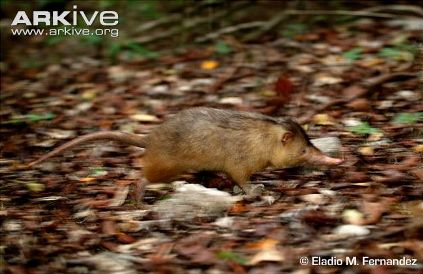Adaptation
S.
paradoxus has acquired several adaptations which allow it
to remain as one of the very few Hispaniolan land mammals left.
It has a magnificent sense of smell and is able to hear very
well; but in return, its eyesight is not near as developed. Its
snout contains sensory whiskers along its length. The
Hispaniolan solenodon has a fast-paced life in the sense that it
is always on the move. However, it is on the move at a rather
slow speed. It could easily beat a
snapping turtle
in a 40 yard dash, but
would be put to shame
by a
cheetah.
S. paradoxus seems a little uncoordinated
at times when trying to run and often struggles to go in a
straight line.

The forelimbs of the Hispaniolan solenodon are much more developed that the hindlegs but all of the limbs have claws with five digits which are used for digging. This creature shows a mix of primitive and derived traits. The primitive characteristics consist of a poisonous bite and the ability to echolocate. Echolocation is the ability to send calls out into the environment and hear the echo from different objects close by. This helps them with feeding and navigation. Also, S. paradoxus has a prootic canal for the lateral head vein. This canal is broadly distributed in Mesozoic mammals but is essentially unknown to placental mammals. Among the more derived characteristics are low birth frequency, low number of young per litter, and its os proboscis bone. This bone is located at the tip of the cartilaginous snout for support.
Venomous Structure
 The most important adaptation of the Hispaniolan solenodon is its
ability to secrete venomous saliva. The venom is secreted from
enlarged submaxillary salivary glands which are located in a groove
in the second lower incisor. The term solenodon actually means
‘grooved tooth’ in Greek. This venom is used as a means of defense
to stun its prey. This is the only documented venom delivery system
in any recent mammal. However, discoveries have
been made to support the hypothesis that salivary venoms and venom
delivery systems have indeed evolved independently in early
mammal lineages.
The most important adaptation of the Hispaniolan solenodon is its
ability to secrete venomous saliva. The venom is secreted from
enlarged submaxillary salivary glands which are located in a groove
in the second lower incisor. The term solenodon actually means
‘grooved tooth’ in Greek. This venom is used as a means of defense
to stun its prey. This is the only documented venom delivery system
in any recent mammal. However, discoveries have
been made to support the hypothesis that salivary venoms and venom
delivery systems have indeed evolved independently in early
mammal lineages.
The grooves in the teeth connect to a duct which supplies a poisonous neurotoxin from glands located below the incisors. This structure is a prime example of convergent evolution with the grooved maxillary fangs of venomous colubroid snakes. The image to the left shows the large groove in incisor of the lower jaw of S. paradoxus.

The venomous toxin that the solenodon secretes is known as the blarina toxin (BLTX) which is a serine protease. It is rated as mild venom, but can still do its job to immobilize prey. Also, if injected into the head of a very small mammal, it can kill it within a few minutes. This toxin has increased catalytic activity and overflows the circulatory system of its prey with the by-product bradykinin, which causes paralysis and sometimes respiratory failure. BLTX has been studied extensively and shows extraordinary molecular convergence with gila toxin, which is found in the venomous Mexican beaded lizard. This lizard has evolved independently through almost the exact same functional changes as the solenodon.Mice that have been given BLTX have suffered from irregular respiration, paralysis, convulsions, and eventually death. Follow this link to see the chemical make-up of the blarina toxin and its amino acid sequence.
Back to Home
Continue to Nutrition

